The Impact of COVID-19 on Food Stockpiling Behavior over Time in China
Abstract
:1. Introduction
2. Literature Review
3. Methodology
3.1. Survey Design
3.2. Model Specification
4. Data Collection and Description
4.1. Data Collection
4.2. Data Description
5. Results
5.1. Motivations of Food Stockpiling
5.2. Consumers’ Perception of the Risk and Duration of COVID-19
5.3. Consumer Food Stockpiling Behavior
5.4. Factors Influencing Consumer Food Stockpiling Behavior
5.5. Factors Affecting the Changes in Stockpiling
6. Conclusions and Discussion
Author Contributions
Funding
Institutional Review Board Statement
Informed Consent Statement
Data Availability Statement
Conflicts of Interest
References
- Wang, E.; An, N.; Gao, Z.; Kiprop, E.; Geng, X. Consumer food stockpiling behavior and willingness to pay for food reserves in COVID-19. Food Secur. 2020, 12, 739–747. [Google Scholar] [CrossRef] [PubMed]
- Martínez, R. COVID-19 Drives Lasting Changes in Global Consumer Behavior and Businesses Operations, Deloitte, Blog. Available online: https://www2.deloitte.com/global/en/blog/responsible-business-blog/2020/covid-19-drives-lasting-changes-in-global-consumer-behavior-and-businesses-operations.html (accessed on 28 October 2021).
- Lufkin, B. Coronavirus: The Psychology of Panic Buying. Available online: https://www.bbc.com/worklife/article/20200304-coronavirus-covid-19-update-why-people-are-stockpiling (accessed on 4 March 2021).
- Wang, H.H.; Na, H. Panic buying? Food hoarding during the pandemic period with city lockdown. J. Integr. Agric. 2020, 19, 2916–2925. [Google Scholar] [CrossRef]
- Hobbs, J.E. Food supply chains during the COVID-19 pandemic. Can. J. Agric. Econ. 2020, 68, 171–176. [Google Scholar] [CrossRef] [Green Version]
- Maclas, C. Is the Food Supply Strong Enough to Weather the COVID-19 Pandemic? Available online: https://www.ucdavis.edu/food/news/is-food-supply-strong-enough-to-weather-covid-19-pandemic (accessed on 28 October 2021).
- Verbeke, W. Impact of communication on consumers’ food choices: Plenary lecture. Proc. Nutr. Soc. 2008, 67, 281–288. [Google Scholar] [CrossRef] [PubMed] [Green Version]
- Arafat, S.Y.; Kar, S.K.; Marthoenis, M.; Sharma, P.; Apu, E.H.; Kabir, R. Psychological underpinning of panic buying during pandemic (COVID-19). Psychiatry Res. 2020, 289, 113061. [Google Scholar] [CrossRef] [PubMed]
- Baddeley, M. Hoarding in the age of COVID-19. J. Behav. Econ. Policy 2020, 4, 69–75. [Google Scholar]
- Lai, J.; Morgan, S.; Kassas, B.; Kropp, J.; Gao, Z. Spending of Economic Stimulus Payments and Changes in Food Purchasing During the COVID-19 Pandemic. Choices 2020, 35, 1–8. [Google Scholar]
- Su, X. Intertemporal Pricing and Consumer Stockpiling. Oper. Res. 2010, 58, 1133–1147. [Google Scholar] [CrossRef] [Green Version]
- Shou, B.; Xiong, H.; Shen, X. Consumer panic buying and quota policy under supply disruptions. Manuf. Serv. Oper. Manag. 2013, 6, 1–9. [Google Scholar]
- Grashuis, J.; Skevas, T.; Segovia, M.S. Grocery shopping preferences during the COVID-19 pandemic. Sustainability 2020, 12, 5369. [Google Scholar] [CrossRef]
- Uhler, A. Changes in Demand and Disrupted Supply Chains Feed into Shortages at the Store. Available online: https://www.marketplace.org/2020/04/13/shortages-at-store-arent-about-peoplestocking-up/ (accessed on 29 May 2021).
- Chang, H.H.; Meyerhoefer, C.D. COVID-19 and the Demand for Online Food Shopping Services: Empirical Evidence from Taiwan. Am. J. Agric. Econ. 2020, 103, 448–465. [Google Scholar] [CrossRef]
- Kulemeka, O. US consumers and disaster: Observing “panic buying” during the winter storm and hurricane seasons. ACR N. Am. Adv. 2010, 37, 837–838. [Google Scholar]
- Kawashima, S.; Morita, A.; Higuchi, T. Emergency stockpiling of food and drinking water in preparation for earthquakes: Evidence from a survey conducted in Sendai city, Japan. J. Hunger Environ. Nutr. 2012, 7, 113–121. [Google Scholar] [CrossRef]
- Terlep, S. Why clorox wipes are still so hard to find. Wall Str. J. 2020. Available online: https://www.wsj.com/articles/why-clorox-wipes-are-still-so-hard-to-find-11588852801 (accessed on 29 May 2021).
- Barrios, J.M.; Hochberg, Y. Risk Perception through the Lens of Politics in the Time of the COVID-19 Pandemic; National Bureau of Economic Research: Cambridge, MA, USA, 2020. [Google Scholar]
- Baker, S.R.; Farrokhnia, R.A.; Meyer, S.; Pagel, M.; Yannelis, C. How does household spending respond to an epidemic? Consumption during the 2020 COVID-19 pandemic. Rev. Asset Pricing Stud. 2020, 10, 834–862. [Google Scholar]
- Dholakia, U. Why Are We Panic Buying During the Coronavirus Pandemic? Psychology Today Hong Kong. Available online: https://www.psychologytoday.com/hk/blog/the-science-behind-behavior/202003/why-are-we-panic-buying-during-the-coronavirus-pandemic?amp (accessed on 27 May 2021).
- Melo, G. The Path forward: US Consumer and Food Retail Responses to COVID-19. Choices 2020, 35, 1–7. [Google Scholar]
- Deas, S. COVID-19: Aussie Pandemic Pantries Packed for Months. Available online: https://www.nielsen.com/au/en/insights/article/2020/covid-19-aussie-pandemic-pantries-packed-for-months/ (accessed on 29 May 2021).
- Gupta, S.; Gentry, J.W. ‘Should I Buy, Hoard, or Hide?’-Consumers’ responses to perceived scarcity. Int. Rev. Retail. Distrib. Consum. Res. 2019, 29, 178–197. [Google Scholar] [CrossRef]
- Hauser, M. Barren Shelves: COVID-19 and Panic Buying of Food. Available online: https://www.cgiar.org/news-events/news/barren-shelves-covid-19-and-panic-buying-of-food/ (accessed on 2 May 2021).
- Dietrich, A.; Knotek, E.S.; Kuester, K.; Muller, G.J.; Myrseth, O.R.; Schoenle, R.; Weber, M. Consumers and COVID-19: A Real-Time Survey. Econ. Comment. 2020, 20202, 1–6. [Google Scholar]
- Hao, N.; Wang, H.H.; Zhou, Q. The impact of online grocery shopping on stockpile behavior in Covid-19. China Agric. Econ. Rev. 2020, 12, 459–470. [Google Scholar] [CrossRef]
- Brehm, J.W. A Theory of Psychological Reactance. Am. J. Psychol. 1968, 81, 133. [Google Scholar]
- Clee, M.A.; Wicklund, R.A. Consumer behavior and psychological reactance. J. Consum. Res. 1980, 6, 389–405. [Google Scholar] [CrossRef]
- Ditto, P.H.; Jemmott, J.B. From rarity to evaluative extremity: Effects of prevalence information on evaluations of positive and negative characteristics. J. Personal. Soc. Psychol. 1989, 57, 16. [Google Scholar] [CrossRef]
- Markus, H.R.; Schwartz, B. Does choice mean freedom and well-being? J. Consum. Res. 2010, 37, 344–355. [Google Scholar] [CrossRef]
- Cogato, A.; Meggio, F.; De Antoni Migliorati, M.; Marinello, F. Extreme weather events in agriculture: A systematic review. Sustainability 2019, 11, 2547. [Google Scholar] [CrossRef] [Green Version]
- Teng, P.; Anthony, M.; Shreshta, M.; Nair, T.; Lassa, J. Food Security: Issues and Perspectives. Available online: https://www.researchgate.net/publication/328635147_Food_Security_Issues_and_Perspectives (accessed on 2 September 2021).
- Fehr, E.; Hoff, K. Introduction: Tastes, castes and culture: The influence of society on preferences. Econ. J. 2011, 121, F396–F412. [Google Scholar] [CrossRef] [Green Version]
- Chuang, Y.; Schechter, L. Stability of experimental and survey measures of risk, time, and social preferences: A review and some new results. J. Dev. Econ. 2015, 117, 151–170. [Google Scholar] [CrossRef] [PubMed]
- Kuroishi, Y.; Sawada, Y. On the Stability of Preferences: Experimental Evidence from Two Disaster. Available online: http://www.crepe.e.u-tokyo.ac.jp/results/2019/CREPEDP61.pdf (accessed on 2 September 2021).
- Lambert, D. Zero-inflated Poisson regression, with an application to defects in manufacturing. Technometrics 1992, 34, 1–14. [Google Scholar] [CrossRef]
- Sheu, M.L.; Hu, T.W.; Keeler, T.E.; Ong, M.; Sung, H.Y. The effect of a major cigarette price change on smoking behavior in California: A zero-inflated negative binomial model. Health Econ. 2004, 13, 781–791. [Google Scholar] [CrossRef]
- Cameron, A.C.; Trivedi, P.K. The role of income and health risk in the choice of health insurance: Evidence from Australia. J. Public Econ. 1991, 45, 1–28. [Google Scholar] [CrossRef]
- China, T.S.C.I. Fighting Covid-19 China in Action. Available online: https://www.chinadaily.com.cn/pdf/2020/FullTextFightingCOVID19.doc (accessed on 2 September 2021).
- Gao, Z.; Li, C.; Bai, J.; Fu, J. Chinese consumer quality perception and preference of sustainable milk. China Econ. Rev. 2020, 59, 100939. [Google Scholar] [CrossRef]
- Akesson, J.; Ashworth-Hayes, S.; Hahn, R.; Metcalfe, R.; Rasooly, I. Fatalism, Beliefs, and Behaviors during the COVID-19 Pandemic. No. w27245; National Bureau of Economic Research: Cambridge, MA, USA, 2020. [Google Scholar]
- Guerrieri, V.; Lorenzoni, G.; Straub, L.; Werning, I. Macroeconomic Implications of COVID-19: Can Negative Supply Shocks Cause Demand Shortages? No. w26918; National Bureau of Economic Research: Cambridge, MA, USA, 2020. [Google Scholar]
- Hawkins, D.I.; Mothersbaugh, D.L. Consumer Behavior: Building Marketing Strategy; McGraw-Hill Irwin: Boston, MA, USA, 2010. [Google Scholar]
- Sheth, J. Impact of Covid-19 on consumer behavior: Will the old habits return or die? J. Bus. Res. 2020, 117, 280–283. [Google Scholar] [CrossRef] [PubMed]
- Lahart, J. The Virus Aftermath Won’t Be Like a Hurricane. Available online: https://www.wsj.com/articles/the-virus-aftermath-wont-be-like-a-hurricane-11583529896 (accessed on 7 March 2021).
- UN News. COVID-19 Cases and Deaths Continue to Decline. Available online: https://news.un.org/en/story/2021/10/1102282 (accessed on 7 November 2021).
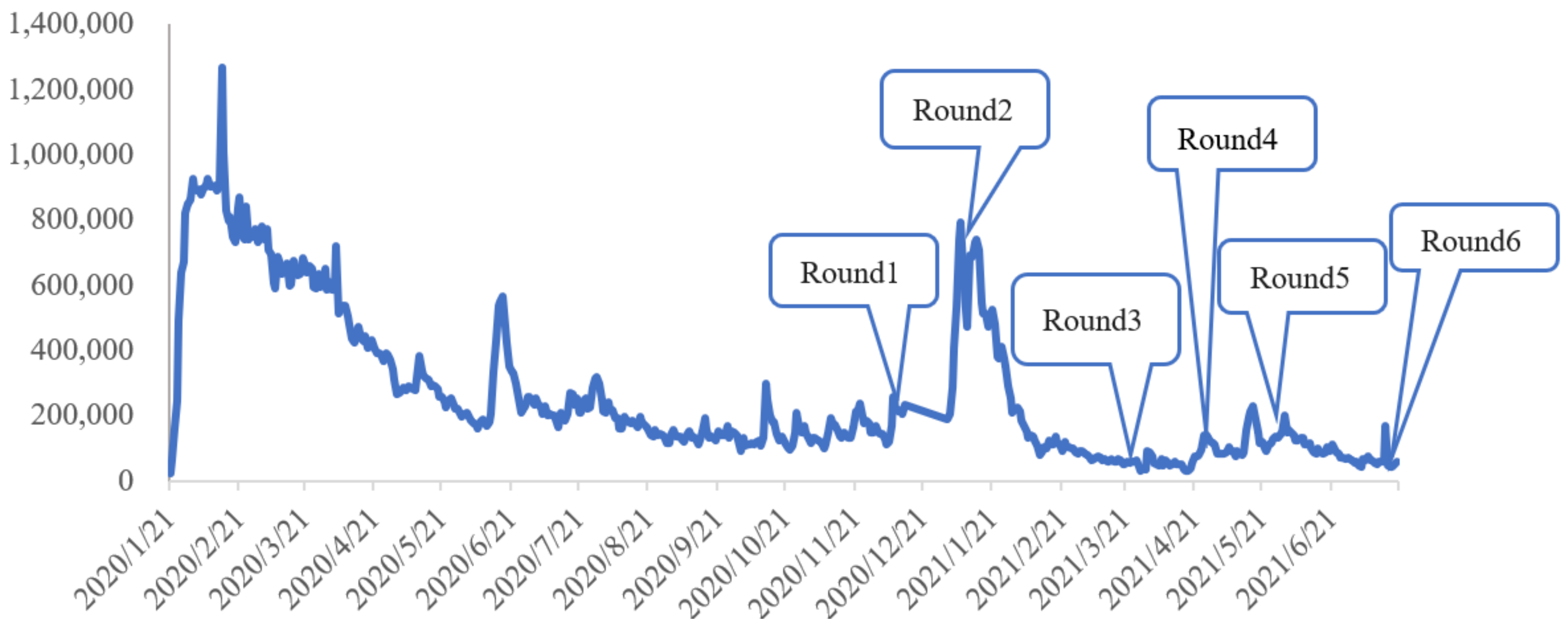
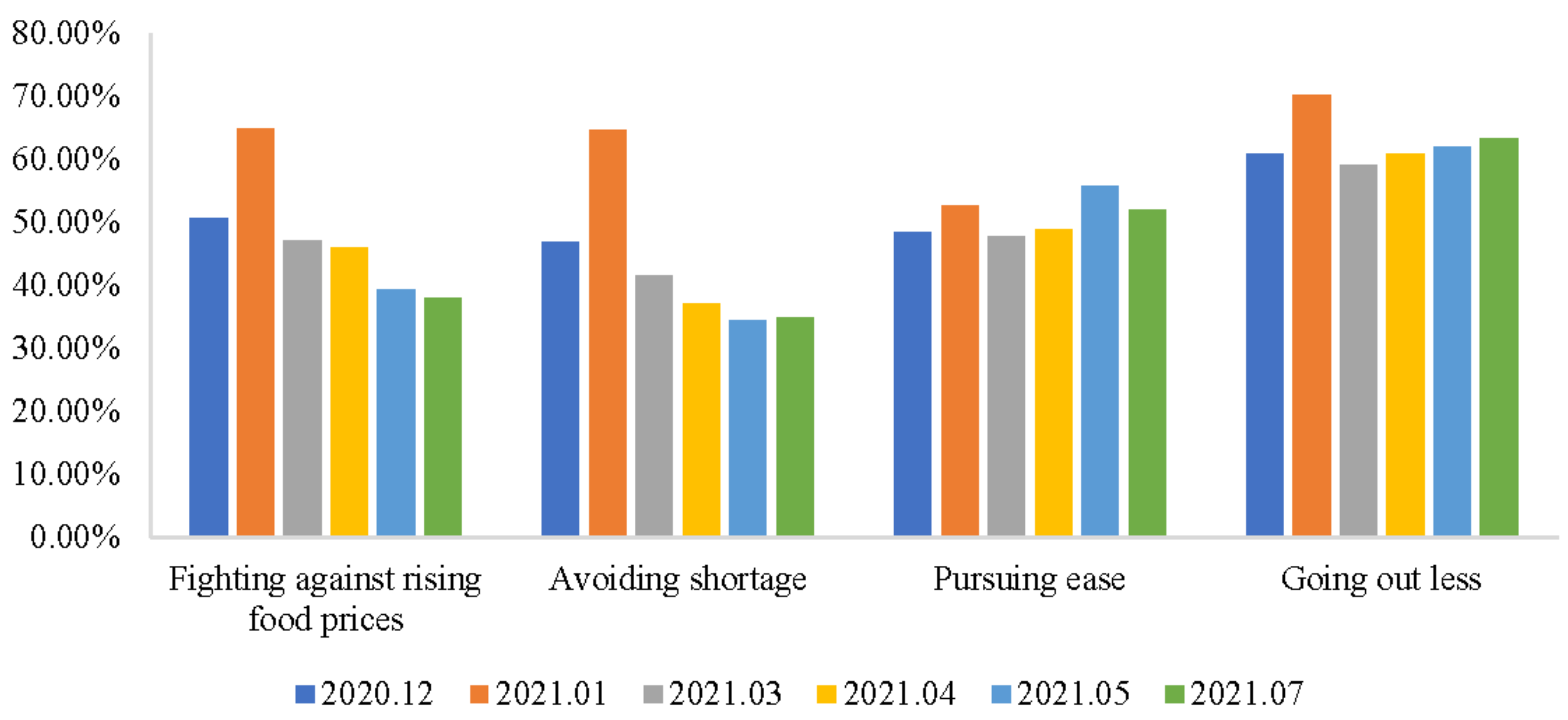
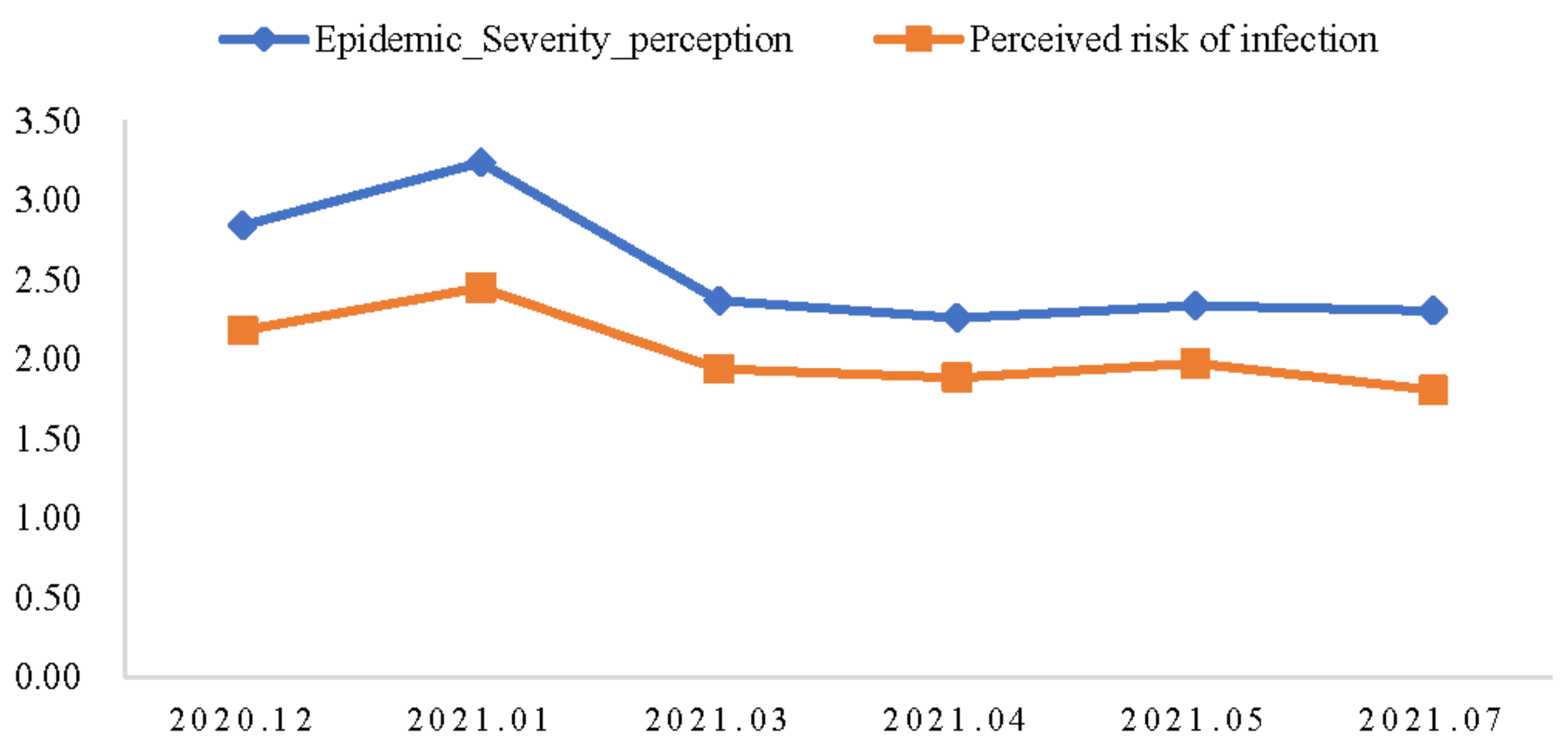
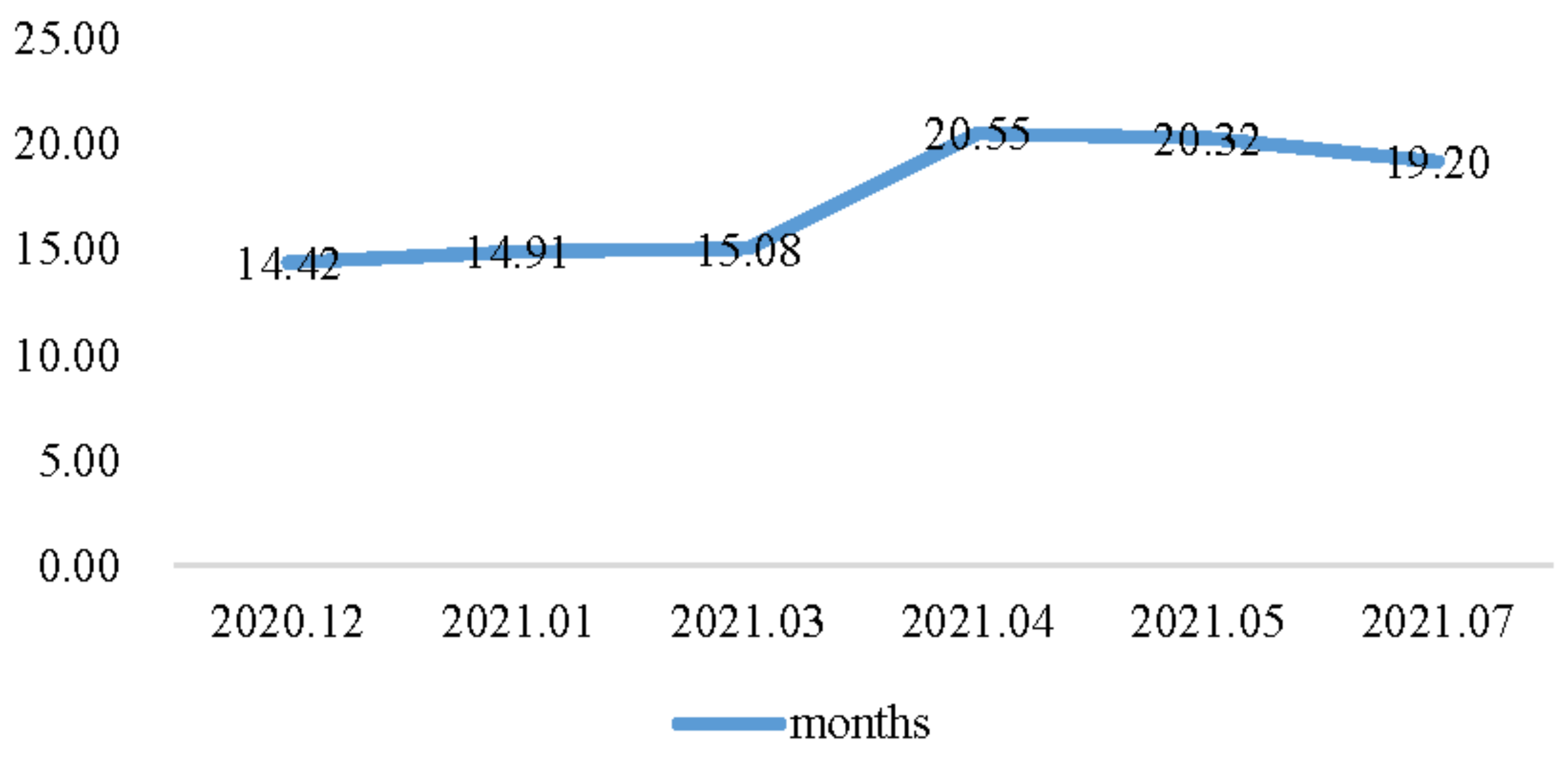
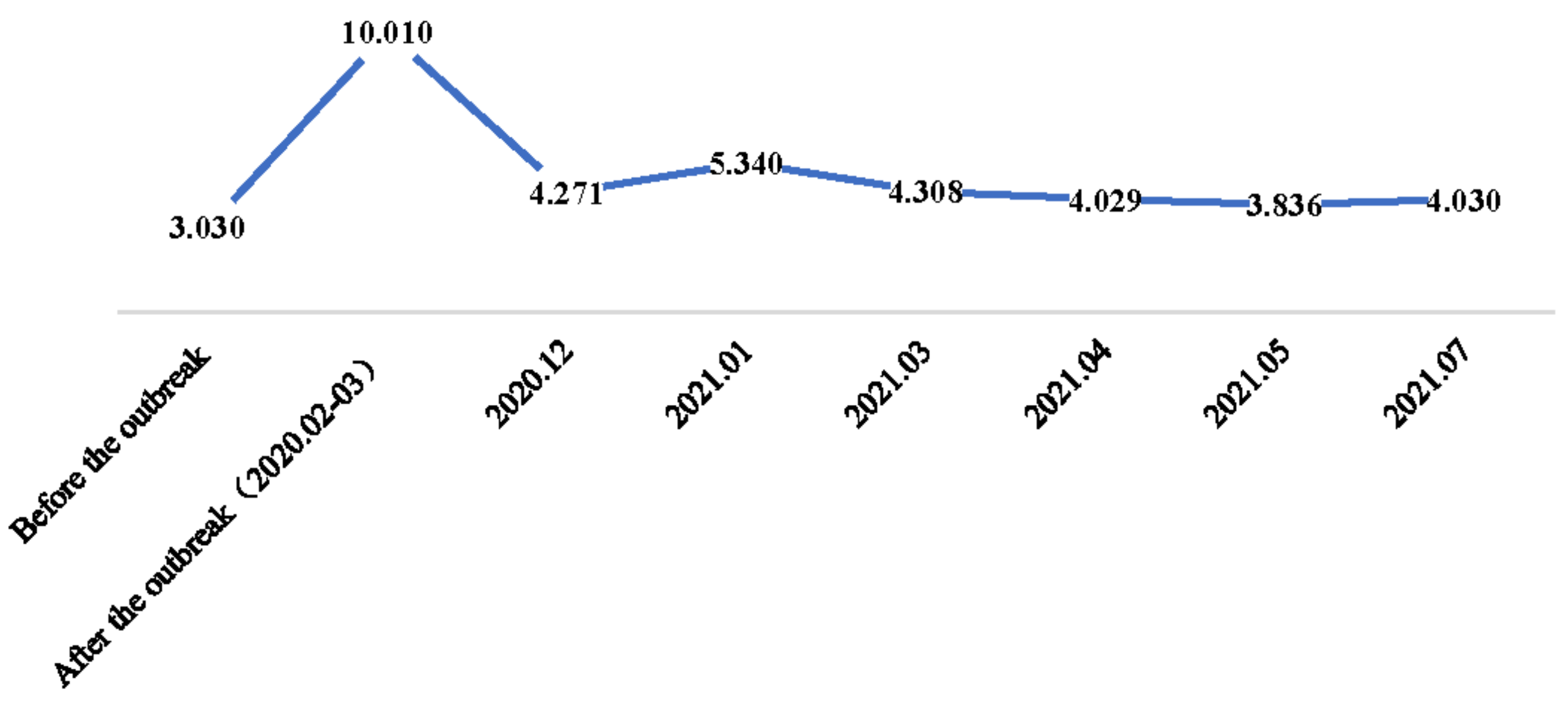
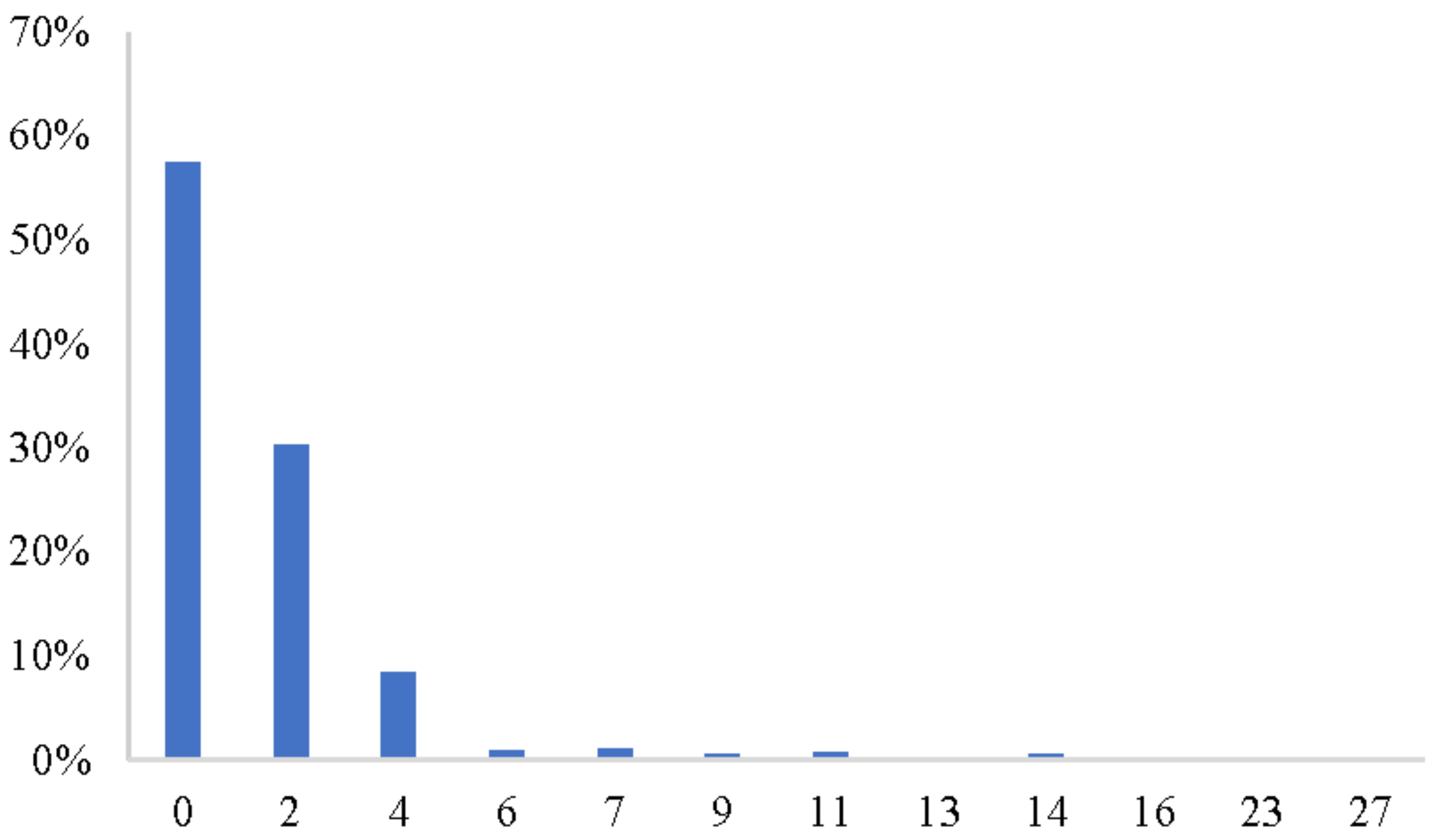
| Variable | Definition |
|---|---|
| The scale of food reserves | How many days’ fresh food reserves do you stockpile now? (1 day, 3 days, 5 days, one week, two weeks, three weeks, and one month) |
| Motivations | What are your motivations for food stockpiling? (Fighting against rising food prices, Avoiding shortage, Pursuing ease, Going out less) |
| Perceived risk of infection | How likely do you think you are to be infected with COVID-19? (5-point Likert scale: 1 = low risk, 5 = high risk) |
| Perceived severity of pandemic | How severe do you think the pandemic is in China? (5-point Likert scale: 1 = not very severe, 5 = very severe) |
| Duration | How long do you think the epidemic will last from now? (number of months) |
| Food stockpiling habit before the pandemic | How many days’ fresh food reserves did you used to stockpile before COVID-19? (1 day, 3 days, 5 days, one week, two weeks, three weeks, and one month) |
| Survey | Date | Major Event Related to COVID-19 |
|---|---|---|
| survey_round 1 | 20–28 December 2020 | |
| survey_round 2 | 20–23 January 2021 | A new wave of COVID-19 cases in China’s Hebei Province in Jan 2021. |
| survey_round 3 | 19–23 March 2021 | |
| survey_round 4 | 20–23 April 2021 | |
| survey_round 5 | 27–28 May 2021 | |
| survey_round 6 | 19–20 July 2021 |
| Sample Variable | 2020.12 (N = 322) | 2021.01 (N = 418) | 2021.03 (N = 355) | 2021.04 (N = 364) | 2021.05 (N = 317) | 2021.07 (N = 323) | Pooled Sample (N = 2099) |
|---|---|---|---|---|---|---|---|
| Gender: | |||||||
| Male | 41.61 | 49.76 | 44.79 | 45.6 | 48.58 | 47.37 | 46.4 |
| Female | 58.39 | 50.24 | 55.21 | 54.4 | 51.42 | 52.63 | 53.6 |
| Age: | 30.94 | 31 | 30.46 | 30.63 | 31.51 | 31.01 | 30.91 |
| Education level: | |||||||
| ≤12 years | 13.04 | 7.18 | 5.92 | 7.97 | 6.31 | 9.91 | 8.29 |
| 13–16 years | 73.91 | 84.21 | 84.79 | 81.87 | 84.54 | 81.11 | 81.9 |
| >16 years | 13.04 | 8.61 | 9.3 | 10.16 | 9.15 | 8.98 | 9.81 |
| Family monthly income: | |||||||
| <4000 yuan | 5.9 | 3.11 | 5.07 | 4.95 | 3.79 | 4.64 | 4.53 |
| 4001–8000 yuan | 17.08 | 18.18 | 16.9 | 16.48 | 12.93 | 14.86 | 16.2 |
| 8001–12,000 yuan | 23.29 | 24.4 | 22.82 | 22.53 | 21.14 | 22.6 | 22.87 |
| 12,001–16,000 yuan | 21.12 | 18.42 | 20.56 | 23.63 | 24.61 | 20.74 | 21.39 |
| 16,001–20,000 yuan | 10.87 | 19.86 | 14.08 | 15.38 | 18.61 | 14.55 | 15.72 |
| 20,001–24,000 yuan | 11.49 | 7.89 | 11.27 | 10.44 | 12.3 | 13 | 10.91 |
| ≥24,001 yuan | 10.25 | 8.13 | 9.3 | 6.59 | 6.62 | 9.6 | 8.38 |
| Children under 12 years old: | |||||||
| No | 40.99 | 44.74 | 34.37 | 41.48 | 31.55 | 32.82 | 38.02 |
| Yes | 59.01 | 55.26 | 65.63 | 58.52 | 68.45 | 67.18 | 61.98 |
| Variables | Model (1) | Model (2) |
|---|---|---|
| Fighting against rising food prices | 0.110 | 0.185 |
| (0.117) | (0.173) | |
| Avoiding shortage | 0.780 *** | 0.931 *** |
| (0.115) | (0.171) | |
| Pursuing ease | 0.471 *** | 0.672 *** |
| (0.107) | (0.159) | |
| Going out less | 0.216 * | −0.196 |
| (0.113) | (0.167) | |
| Perceived severity of the pandemic | 0.298 *** | 0.468 *** |
| (0.071) | (0.106) | |
| Duration | 0.00529 | −0.00447 |
| (0.005) | (0.007) | |
| Food stockpiling habit before the pandemic | 1.020 *** | |
| (0.022) | ||
| Female | 0.215 ** | 0.404 ** |
| (0.106) | (0.157) | |
| Age | 0.00162 | −0.00852 |
| (0.007) | (0.010) | |
| Education level | −0.0781 | 0.292 |
| (0.136) | (0.200) | |
| Income | −0.0158 | −0.0491 |
| (0.034) | (0.051) | |
| survey_round2 | 0.760 *** | 0.695 *** |
| (0.181) | (0.267) | |
| survey_round3 | 0.322 * | 0.34 |
| (0.188) | (0.279) | |
| survey_round4 | 0.349 * | 0.132 |
| (0.188) | (0.278) | |
| survey_round5 | 0.319 | −0.0254 |
| (0.197) | (0.292) | |
| survey_round6 | 0.226 | 0.208 |
| (0.196) | (0.291) | |
| R-sq | 0.58 | 0.078 |
| Adjusted R-sq | 0.576 | 0.07 |
| AIC | 7870.1 | 9265 |
| BIC | 7963.4 | 9352.8 |
| Count Model | Zero Group | |||
|---|---|---|---|---|
| Variables | Coefficient | SE | Coefficient | SE |
| Fighting against rising food prices | 0.097 | 0.070 | −0.053 | 0.140 |
| Avoiding shortage | 0.272 *** | 0.071 | −0.741 *** | 0.139 |
| Pursuing ease | 0.029 | 0.067 | −0.838 *** | 0.134 |
| Going out less | −0.100 | 0.069 | −0.604 *** | 0.134 |
| Perceived severity of pandemic | 0.168 *** | 0.040 | −0.224 *** | 0.082 |
| Duration | 0.002 | 0.003 | −0.005 | 0.006 |
| Female | 0.116 * | 0.066 | −0.093 | 0.127 |
| Age | 0.003 | 0.004 | 0.012 | 0.008 |
| Education level | 0.017 | 0.087 | 0.212 | 0.166 |
| Income | −0.055 ** | 0.022 | −0.053 | 0.044 |
| Child | 0.131 * | 0.074 | −0.228 * | 0.138 |
| Time | 0.058 | 0.104 | −0.403 ** | 0.188 |
| Time × time | −0.007 | 0.015 | 0.059 ** | 0.026 |
| Constant | 0.165 | 0.328 | 1.913 *** | 0.634 |
Publisher’s Note: MDPI stays neutral with regard to jurisdictional claims in published maps and institutional affiliations. |
© 2021 by the authors. Licensee MDPI, Basel, Switzerland. This article is an open access article distributed under the terms and conditions of the Creative Commons Attribution (CC BY) license (https://creativecommons.org/licenses/by/4.0/).
Share and Cite
Wang, E.; Gao, Z. The Impact of COVID-19 on Food Stockpiling Behavior over Time in China. Foods 2021, 10, 3076. https://doi.org/10.3390/foods10123076
Wang E, Gao Z. The Impact of COVID-19 on Food Stockpiling Behavior over Time in China. Foods. 2021; 10(12):3076. https://doi.org/10.3390/foods10123076
Chicago/Turabian StyleWang, Erpeng, and Zhifeng Gao. 2021. "The Impact of COVID-19 on Food Stockpiling Behavior over Time in China" Foods 10, no. 12: 3076. https://doi.org/10.3390/foods10123076
APA StyleWang, E., & Gao, Z. (2021). The Impact of COVID-19 on Food Stockpiling Behavior over Time in China. Foods, 10(12), 3076. https://doi.org/10.3390/foods10123076






